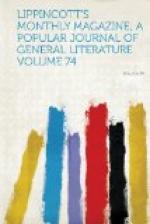One of the peculiar features of low Paris is the shop for the sale of articles at the uniform price of one son. One before which I paused in the Rue Mouffetard was presided over, by two women—evidently grandmother and granddaughter. The former was as grotesque a type of the jolly old vendeuse of Paris as it would be possible to find. A low, winey humor twinkled in her little black eyes, hidden in wrinkly wads of fat; her nose glowed with good feeling; her toothless mouth smirked good-naturedly. A worn shawl covered her chunky shoulders, and a cap like a muslin and flannel extinguisher protected her bald old head from the weather. The granddaughter, being young and rather pretty, was less interesting as a picture of a curious type. The shop occupied a corner, and seemed to literally overflow upon the sidewalks of the two streets, so that care was needful in moving about to avoid stumbling over the profuse array of objects which littered the way. A group of old women were standing near, laughing and chattering in toothless merriment over some mysterious cause of amusement, which I grievously suspected to be myself, the apparition of a foreigner being no doubt an uncommon one in that quarter. But the women of the shop, having an eye to sales, were obsequiously polite to the stranger. I engaged in conversation with the old woman, who proved quite communicative, and set me off on a path of inquiry which yielded information of curious interest.
“Voyez!” cried out the younger woman from behind the broad counter open to the street, and spread with a literally innumerable variety of articles—“Voyez! All one sou! your choice in the sale!”
To study the shop was to find many suggestions of the types of people living in the surrounding buildings—alphabets and whistles for children; playing-cards for gamesters; camphor cigarettes for invalids; sewing-cases for work-girls; mirrors for coquettes; and toys innumerable, “all one sou.” In the grand shops on the fashionable boulevards you may see the last new mode in toys—for no season goes by in Paris without bringing some especial toy or toys to become “the rage”—but in the Rue Mouffetard the toys are all classics. They have been handed down from generation to generation precisely in the forms you see them here. Babies who are now tottering grandfathers and grandmothers played with the toys of the “boutique a un sou” in their day, as the babies of the present do, and paid the same price for them, in spite of the changes of time and the decreased purchasing value of the son in most respects. I bought a large collection of these toys purely as objects of curiosity, and it was really amazing to see, when spread out on a table, what a collection I had gathered for the incredible price of sixteen cents. Many of the toys would be readily recognized as old acquaintances in America, but others, common here for a hundred years past, I never saw at home. The articulated monkey chasing




